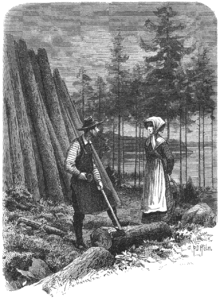Skogsrå

The Skogsrå (Swedish: skogsrået [ˈskʊ̂ksˌroːɛt] (![]() listen); lit. 'the Forest Rå'), Skogsfrun ('the Mistress of the Forest'), Skogssnuvan, Skogsnymfen ('the Forest Nymph'), Råndan ('the Rå') or Huldran, is a mythical female creature (or rå) of the forest in Swedish folklore.[1][2][3]
listen); lit. 'the Forest Rå'), Skogsfrun ('the Mistress of the Forest'), Skogssnuvan, Skogsnymfen ('the Forest Nymph'), Råndan ('the Rå') or Huldran, is a mythical female creature (or rå) of the forest in Swedish folklore.[1][2][3]
It appears in the form of a small, beautiful woman with a seemingly friendly temperament. She appears like a woman from the front but seen from behind she often has a hollow back and a tail.
Those who are enticed into following her into the forest are never seen again. It was said that any human man who has intercourse with the Skogsrå becomes an introvert, as his soul has remained with her. If the seduced man is a hunter, he may be rewarded with good luck in the hunt, but should he be unfaithful to the Skogsrå, he will be punished with numerous accidents. He may put an end to a stormy night caused by her vengeance by firing a shot against her.[4] Late folklore in Nyland describes silver bullets as effective means of killing a skogsrå.[5]
Popular culture[]
The character Esmeralda (played by Happy Jankell) in SVT's thriller television series Jordskott is called "what traditionally would be described as a skogsrå". She is shown having a hollowed back and the ability to drive people to suicide.[citation needed]
References[]
- ^ Granberg, Gunnar (1935). Skogsrået i yngre nordisk folktradition. Skrifter / utg. av Kungl. Gustav Adolfs akademien för folklivsforskning, 99-0440828-9 ; 3 (in Swedish). Uppsala: Lundequistska bokh. SELIBR 321677.
- ^ Hultkrantz, Åke, ed. (1961). The supernatural owners of nature: Nordic symposion on the religious conceptions of ruling spirits (genii loci, genii speciei) and allied concepts. Stockholm studies in comparative religion, 0562-1070 ; 1. Stockholm: Almqvist & Wiksell. SELIBR 541848.
- ^ Häll, Mikael (2013). Skogsrået, näcken och djävulen: erotiska naturväsen och demonisk sexualitet i 1600- och 1700-talens Sverige (in Swedish). Stockholm: Malört. ISBN 978-91-978751-2-7. SELIBR 13887591.
- ^ Rietz, Ernst (1962) [1862–1867]. Svenskt dialektlexikon (in Swedish). Malmö [Lund]: Gleerups. p. 59.
- ^ Finlands svenska folkdiktning II 3:2, s. 330
- Scandinavian legendary creatures
- Swedish folklore
- Legendary creature stubs
- Female legendary creatures
- Forest spirits
